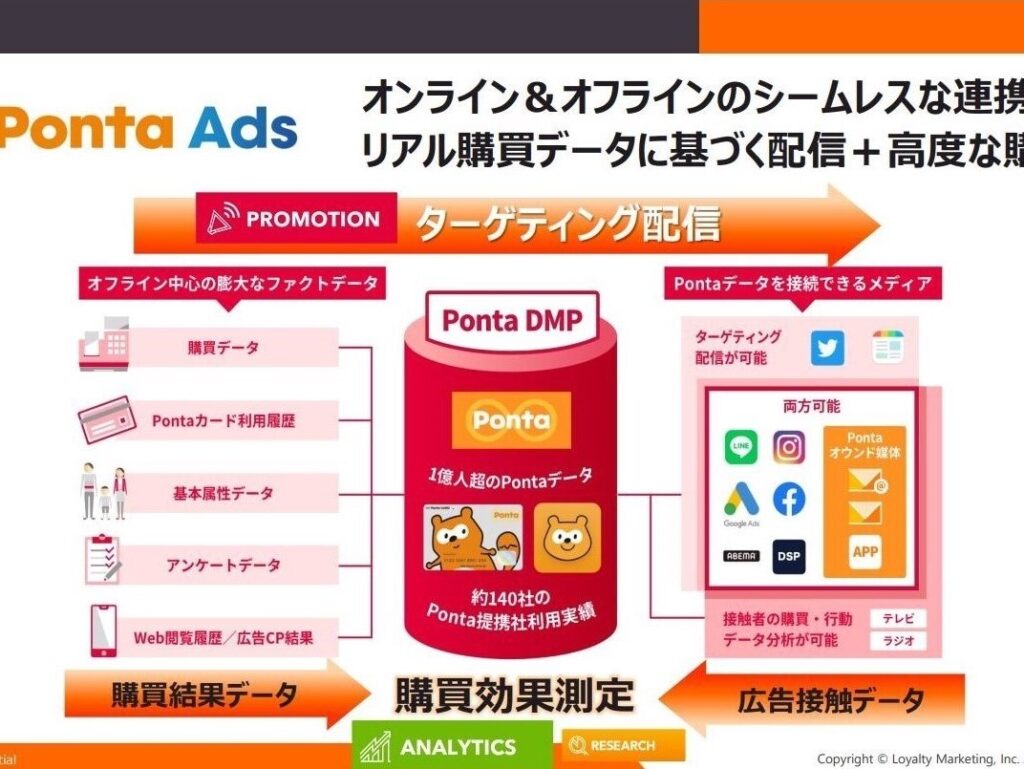Advertisement effect measurement across online and real, realized by “Ponta economic zone” – Japan NEWS

On May 18, Loyalty Marketing held a media seminar on digital marketing efforts centered on the membership base of the company’s point service “Ponta.”
Mr. Takahiro Ogawa, General Manager of Data Innovation Headquarters, Product Management Group, who took the stage at the seminar, shared common challenges in digital and data marketing, such as “regulation of third-party cookies at Apple and Google” and “increasing consumer resistance to unintended use of data.” ”, etc. Among them, the company uses various first-party data to perform ad distribution and analysis that captures people without identifying individuals.
Loyalty Marketing began offering Ponta in 2010. Starting from physical stores, the service expanded to include web services, infrastructure, and cashless payments. As of the end of April 2023, the number of members is about 112.66 million, and as of May 1, 2023, there are 142 affiliated companies (Ponta member stores), 190 brands, and about 280,000 affiliated stores. , expanding the Ponta economic zone.
In the marketing business that utilizes Ponta, purchase/behavior data, etc. centered on physical stores is accumulated in the membership base “Ponta DMP” centered on “Ponta ID”. The company uses the collected data to distribute advertisements on owned media such as the Ponta app and emails for members, as well as major media/platforms such as Google, LINE, and YouTube (Fig. 1). . At the same time, points are given for answering questionnaires, and “Ponta Research”, which has about 2 million members, is being implemented, and support is being provided for data analysis and the development of data utilization infrastructure.
Mr. Ogawa pointed out that when measuring the effect of online advertising on purchases at brick-and-mortar stores, there are cases in which data is divided between online and real stores. For example, in the online domain, advertisements are distributed based on data on the web and evaluated by click-through rates, etc., but in the real domain, it is conceivable that the effect is measured from the total number of purchases. The ideal form is to flexibly utilize online and real data, such as distributing advertisements based on purchase data at physical stores and measuring the effect by the purchase rate and amount of money of those who come into contact with the advertisements. .
He cited the company’s marketing service “Ponta Ads” as a tool to realize this ideal form. By acquiring data such as purchase data centered on the membership base Ponta DMP, and by distributing and analyzing advertisements on the web, it is possible to measure purchasing behavior by utilizing both purchase data and advertisement measurement data. (Figure 2).
As an example of basic targeting and purchase measurement, he introduced a case where an advertisement for a food manufacturer’s product was distributed on Instagram. In this seminar, we assumed that the product was potato chips. In this initiative, we used the ID-POS of a company that sells customer company potato chips among the Ponta partner companies.
As a measurement index, we use ROAS (return on cost of advertising), which is the purchase amount at the actual store of the person exposed to the advertisement divided by the advertisement distribution amount. With ROAS without purchase data set to 1, “purchasers of the same company’s products” who originally bought potato chips from customer companies, “purchasers of the same category products” who bought other snacks and other products of the same genre, and potato We measured the value of each of the “buyers of products in the co-selling category” who buy products that are purchased together with chips.
As a result, ROAS was about 10 times more likely to purchase the company’s same product, about 3 times more likely to purchase the same category product, and about 4 times more likely to purchase the co-sold category product. It is said that the effect was also seen in people other than the purchaser of the product.
Read ZDNET Japan articles every morning by email (free registration)
